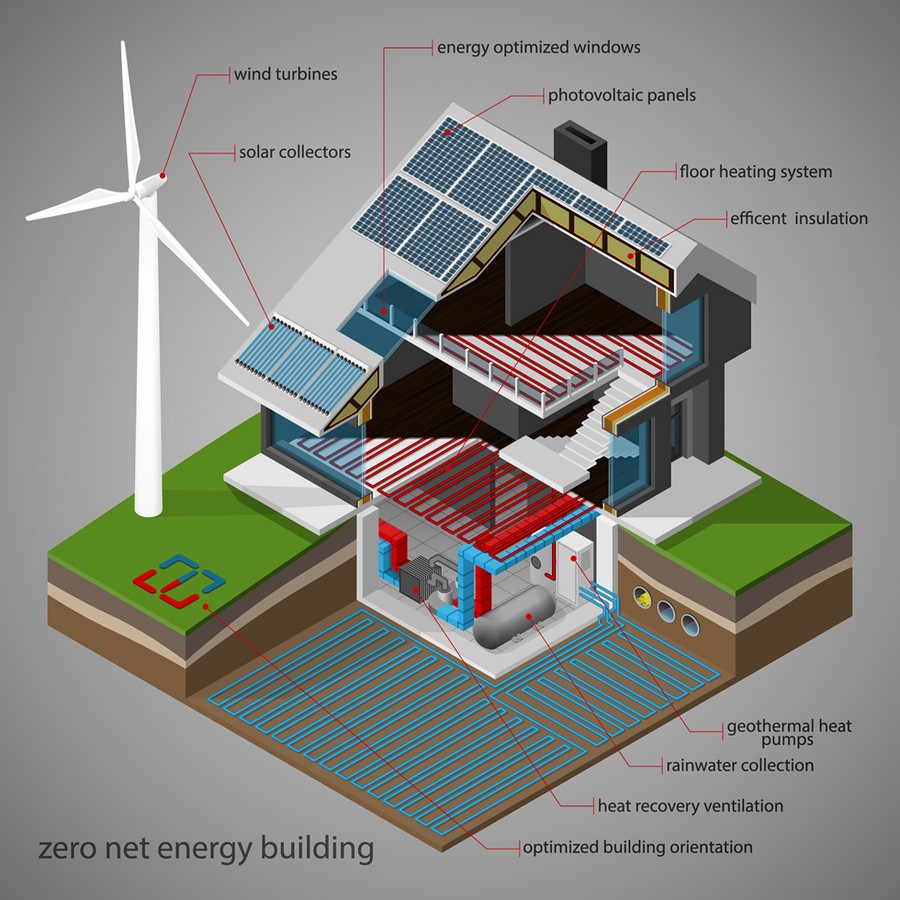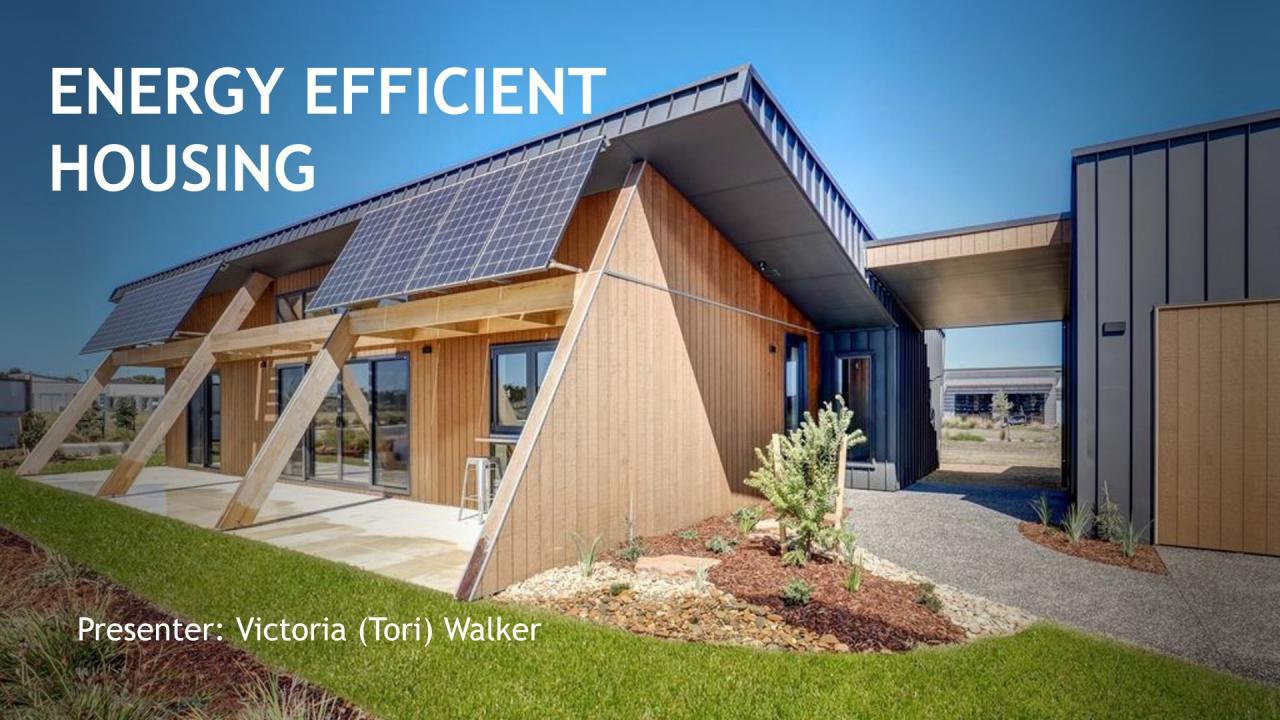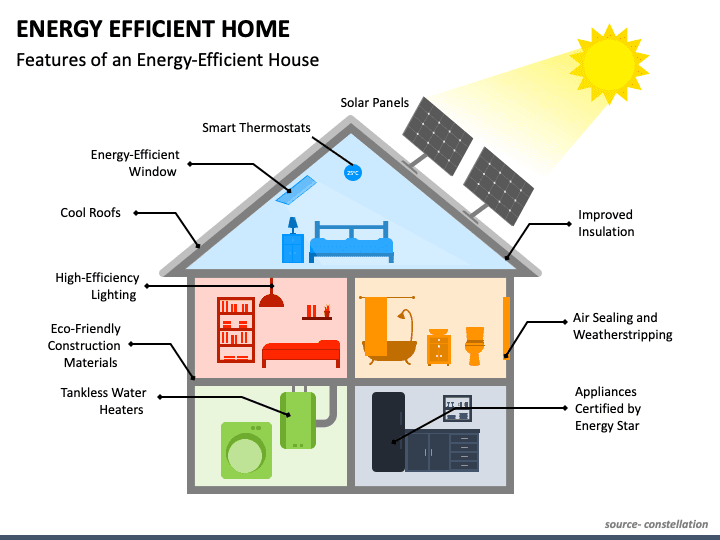Energy-efficient home design ideas are more than just a trend; they’re a smart investment in your comfort and the planet’s future. Building or renovating with energy efficiency in mind can significantly reduce your environmental footprint and lower your utility bills. This exploration delves into practical strategies, from passive solar design and high-performance windows to smart home technology and sustainable materials, empowering you to create a home that’s both eco-friendly and incredibly comfortable.
We’ll cover a range of topics, including optimizing insulation, selecting energy-efficient appliances, and harnessing renewable energy sources like solar power. Learn how strategic window placement can maximize natural light and heat, and discover the benefits of air sealing techniques to minimize energy loss. By the end, you’ll have a comprehensive understanding of how to design and build (or retrofit) a home that’s kind to the environment and your wallet.
Introduction to Energy-Efficient Home Design
Energy-efficient home design prioritizes minimizing energy consumption for heating, cooling, lighting, and appliances. This approach reduces environmental impact and lowers utility bills, leading to significant long-term savings. It involves careful consideration of building materials, construction techniques, and the integration of renewable energy sources.Energy-efficient features offer numerous benefits. Lower energy bills are a primary advantage, freeing up household budgets for other expenses.
Reduced carbon footprint contributes to a healthier environment by lessening greenhouse gas emissions. Increased home comfort is achieved through better insulation and climate control, leading to a more stable and pleasant indoor environment. Furthermore, homes designed for energy efficiency often have a higher resale value due to their increased appeal to environmentally conscious buyers.
Examples of Energy-Efficient Home Design Styles
Various architectural styles can be adapted to incorporate energy-efficient principles. Passive solar design, for instance, strategically uses sunlight to heat the home in winter and shade it in summer. Modern minimalist designs often feature large windows for natural light, reducing the need for artificial lighting, and incorporate sustainable materials like recycled wood or bamboo. Traditional styles can also be updated with energy-efficient upgrades, such as installing high-performance windows and improving insulation.
Green building certifications, such as LEED, provide a framework for creating truly sustainable homes, encompassing energy efficiency and other eco-conscious practices.
Energy-efficient home design ideas often center around smart technology. A key element is incorporating smart lighting, which can significantly reduce energy consumption. Luckily, you don’t need an electrician for this; check out this guide on how to install smart lighting without professional electrician to get started. Once installed, these systems offer programmable schedules and automated adjustments, further enhancing your home’s energy efficiency.
Comparison of Traditional and Energy-Efficient Home Construction
The table below highlights key differences between traditional and energy-efficient home construction methods. It demonstrates how energy-efficient practices, while sometimes requiring a higher upfront investment, ultimately lead to substantial long-term cost savings.
| Method | Traditional Home | Energy-Efficient Home | Cost Comparison |
|---|---|---|---|
| Insulation | Standard fiberglass insulation | High-performance insulation (spray foam, cellulose) | Higher initial cost for energy-efficient insulation, but significant long-term savings on heating and cooling. |
| Windows | Single-pane windows | Double or triple-pane, low-E windows | Higher upfront cost, but reduced energy loss through windows, leading to lower utility bills. |
| HVAC System | Standard air conditioning and heating system | High-efficiency HVAC system with smart thermostat | Higher initial investment, but lower operating costs due to increased efficiency. Smart thermostats further optimize energy use. |
| Building Materials | Conventional materials with less consideration for embodied carbon | Sustainable and recycled materials, minimizing embodied carbon | Potentially higher initial cost for sustainable materials, but contributes to reduced environmental impact and potentially qualifies for tax credits. |
Passive Solar Design Strategies

Source: re-thinkingthefuture.com
Passive solar design harnesses the sun’s energy to heat and cool a building without the use of mechanical systems like pumps or fans. This approach significantly reduces reliance on energy-intensive HVAC systems, leading to lower energy bills and a smaller carbon footprint. By strategically designing a building’s orientation, materials, and features, we can optimize solar gain in winter and minimize it in summer, creating a comfortable and energy-efficient living space.Passive solar design principles reduce energy consumption primarily by minimizing the need for active heating and cooling systems.
Instead of relying on electricity or gas to maintain a comfortable temperature, passive solar design uses the building itself as a thermal mass, storing and releasing heat as needed. This results in significant energy savings and reduced greenhouse gas emissions. Proper design also minimizes heat loss in winter and heat gain in summer, further reducing the energy required for climate control.
Passive Solar Heating and Cooling Floor Plan Design
A well-designed floor plan incorporates passive solar strategies to maximize solar heat gain during the colder months and minimize it during the warmer months. Consider a south-facing orientation (in the Northern Hemisphere) to maximize sunlight exposure in winter. Large south-facing windows allow sunlight to penetrate the home, warming the interior. Thermal mass materials, such as concrete or brick floors and walls, absorb this solar heat during the day and release it slowly at night, maintaining a comfortable temperature even after sunset.
Energy-efficient home design ideas often include smart lighting systems for better control and savings. However, to maximize their lifespan and efficiency, you’ll need to understand the best practices for maintaining and troubleshooting smart home lighting systems. Proper maintenance ensures your smart lights continue to contribute to your overall energy-efficient home goals, saving you money on your energy bills in the long run.
Conversely, during summer, overhangs or strategically placed trees can shade the windows, preventing excessive solar heat gain. In the summer, cross-ventilation can be facilitated through strategically placed windows and doors, allowing for a natural cooling breeze. A simple example could be a two-story home with the main living spaces on the south side, incorporating large windows, and bedrooms on the north side for cooler temperatures during summer.
The south-facing windows would have overhangs to provide shade during the summer months.
Window Placement and Size in Passive Solar Design
The placement and size of windows are critical in passive solar design. South-facing windows (in the Northern Hemisphere) are essential for maximizing solar heat gain during winter. The size of these windows should be carefully considered to balance solar gain with potential heat loss in winter and heat gain in summer. Larger windows will allow more sunlight in but also more heat loss.
Smaller windows reduce heat loss but also limit solar gain. Properly sized windows can maximize solar energy input while minimizing heat transfer. For example, a home in a cold climate might have larger south-facing windows, while a home in a hot climate might have smaller south-facing windows with appropriate shading devices. East and west-facing windows should be smaller to minimize heat gain in summer.
North-facing windows provide diffuse light without direct solar heat gain.
Materials for Passive Solar Building Envelopes
The building envelope, comprising the walls, roof, and windows, plays a vital role in passive solar design. Materials with high thermal mass, such as concrete, brick, and adobe, are ideal for absorbing and storing solar heat during the day and releasing it slowly at night. These materials help to moderate indoor temperatures, reducing the need for heating and cooling.
Insulation is crucial for minimizing heat loss in winter and heat gain in summer. High-performance insulation materials, such as cellulose, fiberglass, or spray foam, should be used in walls, roofs, and floors to create a well-insulated building envelope. Additionally, high-performance windows with low-E coatings and multiple panes significantly reduce heat transfer. For example, a home built with rammed earth walls would have excellent thermal mass properties, while the use of triple-pane windows would minimize heat loss in winter and heat gain in summer.
Insulation and Air Sealing Techniques
Creating a truly energy-efficient home requires a comprehensive approach, and two crucial elements are effective insulation and airtight construction. These work synergistically to minimize heat loss in winter and heat gain in summer, significantly reducing your energy consumption and lowering your utility bills. Proper insulation and air sealing are investments that pay off over the long term, improving comfort and increasing the value of your property.
Insulation Materials and R-Values
Insulation’s effectiveness is measured by its R-value, which represents its resistance to heat flow. A higher R-value indicates better insulation. Various materials offer different R-values and suit different applications. Common insulation types include fiberglass batts and rolls, which are relatively inexpensive and easy to install; cellulose, a recycled paper product offering excellent insulation and fire resistance; spray foam, which provides a continuous air barrier and high R-value; and mineral wool, known for its fire resistance and sound dampening properties.
The choice of insulation depends on factors like budget, climate, and the specific area being insulated. For example, a climate with harsh winters might benefit from higher R-value insulation in the attic, while walls might use a combination of materials for optimal cost-effectiveness and performance. It’s important to consult local building codes and energy efficiency guidelines for recommended R-values in your region.
Air Sealing Techniques
Air sealing focuses on eliminating air leaks throughout the home, preventing drafts and energy loss. Common air leakage points include gaps around windows and doors, cracks in walls and foundations, and penetrations for pipes and wiring. Effective air sealing involves identifying these areas and sealing them with appropriate materials. Caulk is suitable for smaller gaps and cracks, while expanding foam sealant is effective for larger openings.
Weatherstripping can be applied around doors and windows to create a tighter seal. For larger gaps or penetrations, specialized sealants and tapes might be necessary. A thorough air sealing process can significantly reduce energy loss, leading to substantial savings on heating and cooling costs. For example, a home with poor air sealing might lose 20-30% of its heated or cooled air, while a properly sealed home can reduce this loss to less than 10%.
Air Sealing Techniques for Walls, Attics, and Basements
Air sealing techniques vary depending on the area being addressed. Walls often require sealing around electrical outlets, plumbing penetrations, and gaps between wall studs. Attics require sealing around recessed lighting fixtures, chimneys, and access points. Basements often need sealing around foundation cracks, pipes, and windows. Different materials and techniques are used for each area to ensure a proper seal.
For example, using a sealant designed for exterior use is crucial for basement walls exposed to moisture. Similarly, using fire-rated materials around electrical fixtures in attics is a critical safety measure. A comprehensive approach involves inspecting all potential air leakage points in each area and employing the most appropriate sealing method.
Energy-efficient home design ideas often focus on passive strategies like proper insulation and window placement. But smart technology plays a big role too; for example, incorporating automated lighting is a great way to save energy. Check out this guide on setting up automated lighting schedules with different smart home systems to see how easy it is to implement.
Ultimately, combining smart home tech with good design principles leads to a truly energy-efficient home.
Step-by-Step Guide to Insulation Installation, Energy-efficient home design ideas
Proper insulation installation is crucial for maximizing its effectiveness. First, carefully measure the area to be insulated to determine the amount of insulation needed. Then, prepare the area by removing any existing insulation and cleaning the space. Next, carefully install the insulation, ensuring a snug fit and avoiding compression. For batts and rolls, ensure they are properly placed and secured to prevent settling.
For spray foam, follow the manufacturer’s instructions carefully. Finally, inspect the installation to ensure proper coverage and address any gaps or inconsistencies. It is highly recommended to follow manufacturer’s instructions for specific products, as improper installation can reduce the insulation’s effectiveness and potentially cause damage. For example, compressing fiberglass batts significantly reduces their R-value, negating the benefits of the installation.
High-Performance Windows and Doors

Source: amazonaws.com
High-performance windows and doors are crucial components of an energy-efficient home. They significantly impact heating and cooling loads by minimizing heat transfer between the interior and exterior environments. Choosing the right windows and doors can dramatically reduce your energy bills and improve your home’s comfort.High-performance windows and doors achieve superior energy efficiency through several key features. These include multiple panes of glass with low-E coatings, gas fills in the space between panes (like argon or krypton), improved frame materials with superior insulation values, and advanced weatherstripping to prevent air leakage.
These features work together to reduce heat transfer through conduction, convection, and infiltration.
Energy Efficiency Ratings of Different Window Types
Different window types offer varying levels of energy efficiency. Double-pane windows, featuring two panes of glass separated by a gas-filled space, are a common standard, offering improved insulation compared to single-pane windows. Triple-pane windows, with three panes of glass and two gas-filled spaces, provide even greater insulation, reducing heat transfer further. The U-factor (heat transfer coefficient) and Solar Heat Gain Coefficient (SHGC) are key ratings to consider.
A lower U-factor indicates better insulation, while a lower SHGC means less solar heat is transmitted into the home. For example, a double-pane window might have a U-factor of 0.30 and an SHGC of 0.25, while a triple-pane window could achieve a U-factor of 0.20 and an SHGC of 0.20, representing superior energy performance.
Factors to Consider When Selecting Energy-Efficient Windows and Doors
Selecting energy-efficient windows and doors requires careful consideration of several factors. The climate plays a significant role; homes in colder climates will benefit more from higher R-values (insulation resistance) and lower SHGCs, while those in warmer climates might prioritize lower U-factors and higher SHGCs to maximize natural light while minimizing heat gain. The orientation of the windows also matters, with south-facing windows (in the Northern Hemisphere) potentially benefiting from passive solar gain, while west-facing windows might require lower SHGCs to mitigate afternoon heat.
Budget is another crucial factor, as high-performance windows and doors can be more expensive upfront, but the long-term energy savings can justify the investment. Finally, aesthetic considerations, such as style, color, and size, should also be factored into the decision-making process.
Manufacturers of High-Performance Windows and Doors
Many reputable manufacturers produce high-performance windows and doors. It’s important to research and compare options based on your specific needs and budget. Some well-known manufacturers include Andersen, Marvin, Pella, Jeld-Wen, and Milgard. Each manufacturer offers various lines of windows and doors with different performance characteristics and price points. It’s recommended to consult with a qualified window and door installer to determine the best options for your home and climate.
Energy-Efficient Appliances and Lighting

Source: com.au
Choosing energy-efficient appliances and lighting is crucial for minimizing your home’s environmental impact and lowering your energy bills. By making smart choices in these areas, you can significantly reduce your carbon footprint and save money over the long term. This section explores the benefits of energy-efficient appliances and LED lighting, and highlights the role of smart home technology in optimizing energy consumption.
Energy-Efficient Appliances and Their Energy Star Ratings
The Energy Star program provides a valuable resource for identifying energy-efficient appliances. Appliances with the Energy Star rating meet strict energy-efficiency guidelines, indicating that they consume less energy than standard models. This translates to lower operating costs and reduced environmental impact.
- Refrigerators: Energy Star certified refrigerators use significantly less electricity than older models. Look for features like advanced insulation and efficient compressors. For example, a typical Energy Star refrigerator might use 30% less energy than a non-certified model of similar size.
- Washing Machines and Dryers: High-efficiency washing machines use less water and energy, often featuring variable-speed motors and improved wash cycles. Similarly, heat pump dryers are far more energy-efficient than traditional electric or gas dryers. A heat pump dryer can use up to 50% less energy.
- Dishwashers: Energy Star certified dishwashers offer features such as optimized water usage and shorter wash cycles. These improvements lead to substantial energy and water savings over the lifespan of the appliance.
LED Lighting vs. Incandescent Bulbs
LED (Light Emitting Diode) lighting offers numerous advantages over traditional incandescent bulbs. LEDs are significantly more energy-efficient, lasting much longer and producing less heat.
Energy-efficient home design ideas often include smart technology to minimize energy waste. A key element is smart lighting, and to help you choose the best system, check out reviews of top rated smart home lighting apps and compatibility for a comprehensive guide. By carefully selecting your smart lighting, you can significantly enhance the overall energy efficiency of your home design.
While incandescent bulbs convert most of their energy into heat, LEDs convert a much higher percentage into light. A typical 60-watt incandescent bulb can be replaced with a 10-watt LED bulb that produces the same amount of light. This translates to a substantial reduction in energy consumption and associated costs. Furthermore, LEDs have a much longer lifespan, typically lasting 25,000 hours or more compared to the 1,000-hour lifespan of an incandescent bulb, reducing replacement costs.
Smart Home Technology for Energy Management
Smart home technology provides advanced control over energy consumption within a residence. Smart thermostats, for example, learn your preferences and adjust temperatures accordingly, optimizing heating and cooling based on occupancy and weather conditions. Smart plugs allow you to monitor and control the energy usage of individual appliances, identifying and addressing areas of high consumption. Some systems even integrate with renewable energy sources, allowing for optimized use of solar or wind power.
For instance, a smart thermostat can automatically lower the temperature when you’re away from home, saving significant energy compared to a traditional thermostat.
A Sample Energy-Efficient Lighting Plan
A well-designed lighting plan incorporates energy-efficient fixtures and strategically placed lighting sources to maximize illumination while minimizing energy use.
Consider a combination of ambient, task, and accent lighting. Ambient lighting provides general illumination throughout a room, often achieved with recessed LED downlights or energy-efficient ceiling fans with integrated lights. Task lighting, such as under-cabinet lighting in the kitchen or desk lamps, provides focused illumination for specific activities. Accent lighting highlights architectural features or artwork, using low-wattage LED spotlights. For instance, a living room could use dimmable LED recessed lights for ambient lighting, supplemented by floor lamps with energy-efficient LED bulbs for task lighting, and small LED spotlights to highlight artwork on the walls.
Sustainable Building Materials
Choosing sustainable and locally sourced building materials is crucial for creating energy-efficient homes with a reduced environmental footprint. These materials not only contribute to better thermal performance but also minimize the embodied energy – the energy consumed in the extraction, processing, manufacturing, transportation, and installation of building materials. This section explores various options, their environmental impact, and their thermal properties.
Sustainable building materials offer a multitude of benefits beyond energy efficiency. They often boast improved indoor air quality, reduced reliance on non-renewable resources, and support local economies. The selection of appropriate materials should consider factors like climate, availability, and the overall design of the house.
Locally Sourced Lumber and Timber
Using locally harvested lumber reduces transportation costs and emissions associated with long-distance shipping. Hardwoods like oak and maple, while more expensive, offer superior durability and insulation compared to softwoods. The embodied carbon in wood is significantly lower than that of many manufactured materials, making it a relatively carbon-neutral option. Proper forestry management practices are vital to ensure sustainable sourcing.
For example, sustainably managed forests in the Pacific Northwest provide high-quality lumber with minimal environmental impact, while also supporting local economies.
Recycled and Reclaimed Materials
Recycled materials offer a significant opportunity to reduce waste and lower the environmental impact of construction. Examples include using recycled steel for structural components, recycled glass for insulation, and reclaimed wood for flooring or trim. Reclaimed wood, in particular, often possesses unique character and durability, adding aesthetic value while reducing the demand for newly harvested timber. Using recycled content in concrete reduces the need for cement production, a process that contributes significantly to greenhouse gas emissions.
For instance, a project might incorporate recycled concrete aggregate, reducing the overall carbon footprint of the concrete used in the foundation or walls.
Natural Insulation Materials
Many natural materials provide excellent thermal insulation, reducing the need for energy-intensive synthetic options. Examples include sheep’s wool, cellulose (made from recycled paper), straw bales, and hempcrete (a mixture of hemp fibers and lime). These materials offer good thermal mass, helping to regulate indoor temperatures and reduce energy consumption for heating and cooling. Sheep’s wool insulation, for example, offers excellent thermal performance while being a renewable and biodegradable resource.
Cellulose insulation, derived from recycled paper, provides superior insulation and sound dampening properties compared to fiberglass.
Rammed Earth and Cob
Rammed earth, a mixture of soil, gravel, and stabilizer, is a durable and energy-efficient building material with excellent thermal mass. Cob, a similar material using a mixture of clay, sand, and straw, offers a more rustic aesthetic. Both are readily available in many regions and require minimal processing, reducing their environmental impact significantly. The thermal mass of rammed earth walls helps to moderate indoor temperatures, reducing the need for extensive heating or cooling systems.
In arid climates, rammed earth buildings can stay cool during the day and retain heat at night, creating a comfortable and energy-efficient living space.
Comparing Thermal Properties
The thermal performance of sustainable building materials is often expressed using their R-value (resistance to heat flow) or U-value (rate of heat transfer). Higher R-values indicate better insulation. While specific values vary based on thickness and material density, generally, materials like sheep’s wool, cellulose, and straw bales offer comparable or even superior R-values to traditional fiberglass insulation. Rammed earth and cob walls, due to their high thermal mass, exhibit excellent thermal inertia, meaning they resist temperature fluctuations.
This can significantly reduce the load on heating and cooling systems.
Renewable Energy Sources for Homes
Harnessing renewable energy is a crucial step towards creating truly energy-efficient homes. By utilizing naturally replenishing resources, homeowners can significantly reduce their carbon footprint and potentially lower their energy bills. Several renewable energy options are readily adaptable for residential use, each with its own advantages and considerations.
Renewable energy sources offer a compelling alternative to traditional fossil fuel-based energy. They provide a sustainable and environmentally friendly way to power our homes, reducing reliance on finite resources and mitigating the effects of climate change. The integration of these systems can range from simple additions to more complex, whole-home energy solutions.
Solar Energy Integration in Home Design
Solar panels, the most common form of residential renewable energy, convert sunlight directly into electricity. Integrating them effectively involves careful consideration of roof orientation, shading, and available sunlight hours. South-facing roofs (in the Northern Hemisphere) generally offer optimal performance. The installation process typically involves mounting panels on the roof, connecting them to an inverter (which converts DC power to AC power for home use), and connecting the system to the home’s electrical panel.
System size depends on energy consumption needs and available roof space. Aesthetic considerations, such as the choice of panel type and mounting system, are also important to maintain the home’s visual appeal. Proper permitting and professional installation are essential for safety and efficiency.
Economic Benefits and Environmental Impacts of Renewable Energy
Using renewable energy sources provides significant economic and environmental advantages. While initial installation costs can be substantial, long-term savings on electricity bills are often substantial, leading to a positive return on investment over time. Government incentives, such as tax credits and rebates, can further reduce the upfront costs. From an environmental perspective, renewable energy drastically reduces greenhouse gas emissions compared to fossil fuels, contributing to cleaner air and a healthier planet.
Furthermore, reliance on renewable energy reduces dependence on volatile global energy markets, increasing energy security and independence. For example, a family in California using solar panels might see their electricity bill reduced by 70% annually, while also significantly lowering their carbon footprint.
Visual Representation of a Home with Multiple Renewable Energy Sources
Imagine a two-story house with a steeply pitched, south-facing roof covered in solar panels. The panels are dark-grey, seamlessly integrated into the roofline, maintaining a sleek, modern aesthetic. A small, aesthetically pleasing wind turbine is positioned on a raised platform in the backyard, away from any potential obstructions. The house itself is constructed with energy-efficient materials, including high-performance windows and thick insulation.
Beneath the ground, a geothermal heat pump system silently provides efficient heating and cooling. The house’s landscaping incorporates native, drought-tolerant plants, minimizing water usage. The overall impression is one of sustainable elegance – a home that is both visually appealing and environmentally responsible, effectively showcasing the harmonious integration of multiple renewable energy technologies.
Smart Home Technology and Energy Management

Source: com.au
Smart home technology offers a powerful way to optimize energy consumption and reduce your environmental impact. By integrating various devices and systems, you can gain greater control over your home’s energy use, leading to significant savings on your utility bills and a smaller carbon footprint. This section explores how smart thermostats and other smart home devices can contribute to a more energy-efficient lifestyle.Smart thermostats, for example, learn your preferences and adjust the temperature accordingly, minimizing energy waste.
Other smart devices, such as smart plugs and lighting systems, allow for precise control and automation of energy-consuming appliances and lights. This level of control and automation provides opportunities for significant energy savings.
Smart Thermostat Functionality
Smart thermostats go beyond basic programmable thermostats by learning your heating and cooling preferences over time. They use algorithms to predict your needs and adjust the temperature automatically, ensuring optimal comfort while minimizing energy consumption. Many models offer features like geofencing, which automatically adjusts the temperature based on your location, and integration with other smart home systems for a more holistic energy management approach.
For example, a smart thermostat could automatically lower the temperature when you leave home and raise it again before you return, preventing unnecessary energy use. Some even provide detailed energy usage reports, allowing you to identify areas for improvement and track your progress.
Energy Management System Features
Energy management systems (EMS) provide a centralized platform for monitoring and controlling various energy-consuming devices in your home. These systems typically offer a user-friendly interface, either through a mobile app or a dedicated control panel, allowing you to view real-time energy usage data, set schedules, and automate actions. Advanced EMS can integrate with renewable energy sources, such as solar panels, to optimize energy production and consumption.
They may also incorporate features like energy usage alerts, allowing you to quickly identify and address potential energy waste. An example would be an EMS that automatically switches off lights in unoccupied rooms or reduces the power consumption of appliances during peak hours.
Benefits of Smart Home Energy Monitoring and Control
Using smart home technology for energy monitoring and control offers several key benefits. Firstly, it provides real-time insights into your energy consumption patterns, allowing you to identify areas where you can reduce energy waste. Secondly, it enables automated control of energy-consuming devices, optimizing their operation for maximum efficiency. Thirdly, it facilitates the integration of renewable energy sources, maximizing the use of clean energy.
Finally, it contributes to reduced energy bills and a smaller carbon footprint. By gaining a clear understanding of your energy usage and implementing smart controls, you can make informed decisions that positively impact both your wallet and the environment.
Comparison of Smart Home Energy Management Systems
The following table compares various smart home energy management systems available on the market. Note that prices and user reviews can vary based on specific models and retailer.
| System Name | Key Features | Cost (Approximate) | User Reviews (Summary) |
|---|---|---|---|
| Nest Learning Thermostat | Learning algorithms, geofencing, energy reports, app control | $200 – $300 | Generally positive, praised for ease of use and energy savings |
| Ecobee SmartThermostat | Room sensors, Alexa integration, remote access, energy reports | $200 – $300 | Highly rated, users appreciate the accuracy and smart features |
| Honeywell Lyric T5 | Smart scheduling, remote access, geofencing, compatibility with other smart home devices | $150 – $250 | Positive reviews, known for its reliability and straightforward interface |
| Amazon Smart Home Hub | Centralized control of various smart home devices, energy monitoring capabilities | $50 – $100 | Mixed reviews, some users find the interface less intuitive than others |
Final Conclusion
Designing an energy-efficient home isn’t just about saving money; it’s about creating a healthier, more sustainable living space. By implementing the strategies discussed—from passive solar design to smart home technology—you can significantly reduce your energy consumption and carbon footprint. Remember, every small step contributes to a larger, positive impact. Embrace these ideas, and build a home that reflects your commitment to both comfort and environmental responsibility.
Questions Often Asked: Energy-efficient Home Design Ideas
What are the upfront costs of building an energy-efficient home?
Initial costs can be higher than traditional construction, but long-term savings on energy bills often offset this. The exact increase depends on the specific features implemented.
How long does it take to recoup the investment in energy-efficient upgrades?
The payback period varies depending on factors like energy prices, climate, and the type of upgrades. However, many homeowners see a return on their investment within a few years.
Can I retrofit an existing home to be more energy-efficient?
Absolutely! Many energy-saving improvements can be added to existing homes, such as improved insulation, more efficient windows, and smart thermostats.
Are there government incentives for energy-efficient home improvements?
Yes, many governments offer tax credits, rebates, and other incentives to encourage energy efficiency. Check your local and national programs for available options.
What is the role of proper ventilation in energy efficiency?
Proper ventilation is crucial. It removes moisture, prevents mold growth, and ensures good indoor air quality, all while minimizing energy waste by preventing the need for excessive heating or cooling.



